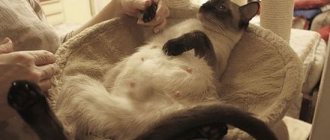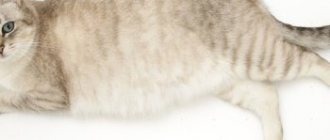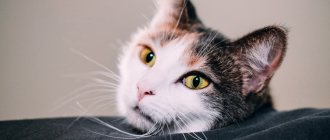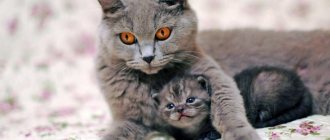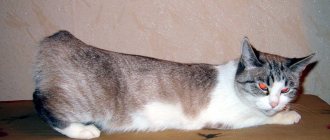Expecting kittens is always a very exciting stage for both the cat and the owner. Pregnancy in cats is different from that in women. In animals, childbirth takes place at the level of natural instincts and has a number of features. During this period, the cat needs to be provided with special care and know the finer points. In the article we will describe the stages of a cat’s pregnancy, the features of bearing kittens, and possible complications during this period. You will also learn how to organize care for a pregnant cat, tips for comfortable conditions during childbirth and after.
Childbearing age
During puberty, physiological changes occur in the kitten's body, after which it becomes capable of reproducing. The period of onset of childbearing age depends on the following factors:
- breed
- diet
- individual characteristics
- conditions of detention
Short-haired breeds, such as Britons and Siamese cats, mature earlier. Puberty occurs at the age of 5-6 months.
In long-haired and large cats, the first heat comes at 10-12 months.
The optimal age for procreation is from one to one and a half years. Cats give birth without harm to their health starting from the second or third heat.
Interesting to know
Theoretically, a cat can become pregnant at any reproductive age because estrus occurs throughout her life. There is a known case where a cat from Great Britain gave birth to two kittens at the age of 30.
Preparing cats for pregnancy
The health of the pet and kittens will depend on proper preparation of the cat for pregnancy. It is useful for owners to know how many months to expect kittens, and what needs to be provided for the cat when bearing offspring.
Any pet needs a balanced diet, especially a pregnant cat. Sometimes expectant mothers suffer from mineral and vitamin deficiencies. This factor has a detrimental effect on development in the womb. That is why, before planning a pregnancy, it is recommended to provide your cat with the right varied diet.
In the process of preparing a cat for pregnancy, it is also advisable to carry out mandatory vaccination and deworming. The fact is that kittens receive antibodies to various diseases along with their mother's milk. Infections are also transmitted to babies.
The final stage is choosing a partner for mating. The choice of a suitable male depends on the breed and pedigree of the cat.
The most optimal period for mating is the third day of estrus. Therefore, it is recommended to introduce the cat to the cat on the second day.
Important
Trying to cover your cat too early on the first day can cause her to become seriously stressed and her heat to stop.
Early abortion: how to prevent
To avoid a situation where artificial termination of pregnancy is necessary, it is advisable to control the menstrual cycle, especially if pregnancy is undesirable at this stage. It is also important to use a reliable method of contraception. Your doctor will help you choose the most appropriate and effective method. If an unwanted pregnancy continues, you should consult a doctor as soon as possible to terminate it. The day after an early abortion, as with any other artificial termination of pregnancy, is the day of a new cycle, when the next pregnancy can already occur, so you should immediately choose the optimal method of contraception.
Some women mistakenly believe that it is not difficult to perform a premature abortion at home on their own. Such an event could cost the life of an unlucky mother or seriously harm her health. Under no circumstances should you try to induce a miscarriage, but you should always seek medical help.
How long does pregnancy last in cats?
To prepare for childbirth, the owner should know how many weeks or months pregnancy lasts in cats. How long they stay pregnant depends on the breed of cat. The average gestational period (a measure of pregnancy age) is 9 weeks for short-haired breeds, and 10 weeks for long-haired breeds.
| Cat breed | Duration of pregnancy in days |
| Siamese | 59-64 |
| oriental | 65-66 |
| Maine Coon | 66-68 |
| Scottish lop-eared | 62-69 |
| sphinx | 63-66 |
| British Shorthair | 63-69 |
| Bengali | 61-70 |
| Persian | 63-69 |
A cat can become pregnant three times a year, but this frequency negatively affects its health and life expectancy. Therefore, veterinarians advise breeding a pet no more than three times every two years.
Cat pregnancy calendar by week
The onset of pregnancy in cats is accompanied by behavioral characteristics each week. Active development of embryos begins at the end of the second week after conception.
1 week (0-7 days)
During this period, the fertilized egg divides. It is almost impossible to determine the presence of pregnancy.
2 week (8-14 days)
During this period, fertilized eggs are implanted in the uterus. The process of formation of the placenta and embryos begins.
Week 3 (15-21 days)
This week the embryos develop internal organs.
Week 4 (22-29 days)
During the ultrasound, you can already hear the kittens' heartbeat. During this period, it is recommended to be as careful as possible with a pregnant cat: do not pick it up unnecessarily, do not put pressure on the belly.
Week 5 (30-37 days)
Allows you to determine the number of kittens. At the beginning of this week, kittens have already formed paws, pads and soft nails.
6-7 week (38-52 days)
Owners should carefully monitor the nutrition and psychological comfort of their pet, since during these weeks the nervous system of the embryos is formed. X-rays show the complete skeleton of kittens. At the end of the week, the babies are covered with soft fur.
Week 8 (53-60 days)
At this stage, kittens of some breeds are already ready to be born.
9-10 week (61-75 days)
The kittens are already fully formed and ready to be born.
It is quite difficult to calculate exactly how many kittens a cat will bear. It should be taken into account that the offspring is ready for life outside the womb after the 58th day of pregnancy.
Features of pregnancy
In cats, the opportunity for fertilization appears after the onset of puberty. For the first 6 months, the cat is considered a kitten, and you don’t have to think about pregnancy yet. But in order to further determine a cat’s pregnancy and its timing, you need to become familiar with the concept of estrus in an animal.
A cat's heat is the beginning of puberty.
A cat's heat is the onset of puberty, therefore the period when a cat can become pregnant for the first time. For the owner, this will be a signal about the animal’s ability to fertilize after mating with a cat.
Some features of the onset and course of pregnancy:
- During the year, a cat may come into heat 2-3 times;
- during the period of heat, the pet changes greatly in behavior: it falls to the floor and begins to rub its stomach and back, while meowing without stopping, it can rub against people, sometimes it makes marks around the house;
During the period of estrus, your pet changes a lot in behavior
- at the beginning of estrus, days 1 and 2, the cat loses its appetite, meowing becomes loud and intense, however, when meeting a cat these days, the cat may not let him near her, but after the first days of estrus, the cat will be ready for mating;
- It is quite rare to see a pregnant cat after the start of her first heat; fertilization usually occurs as a result of several meetings with the opposite sex;
If the owner has a need to sterilize a pet, then it should be remembered that this procedure is best carried out in a cat after pregnancy, first or secondary, it does not matter, the main thing is to know how to correctly determine the moment of puberty and only then contact a specialist.
Number of kittens and gestational age
The maximum number of kittens a cat can produce depends on the number of attachment sites for fertilized eggs in the uterus. On average, a cat gives birth to 4 to 6 kittens. At young and old ages, the number of offspring is significantly lower.
Interesting to know
Some breeders believe that the maximum number of kittens that a cat can give birth to can be calculated independently. To do this, just use a simple formula: subtract 2 from the total number of cat nipples.
The length of time cats are pregnant depends on how many kittens are preparing to be born. If there are less than five kittens in the belly, the pregnancy lasts 9-10 weeks; if more, labor may begin a little earlier than expected.
Owners can find out the number of expected offspring as early as the fifth week of a cat's pregnancy.
How to choose a clinic
When choosing a clinic where your animal will be examined and treated, pay attention to the following points:
- attendance should be as high as possible;
- look at reviews of all nearby clinics on the Internet, choose the one with the least negative ones;
- visit the clinic and see for yourself the environment and sanitary conditions;
- ask for feedback through social networks, or ask your friends about the quality of services provided.
Also take a closer look at the staff, they should not be rude.
If something in the clinic itself did not suit you (there was an unpleasant smell, repairs had not been carried out for a long time, and so on), and the reviews about the specialist are only the most reliable, then ask if there is a service for a veterinarian to come to your home with equipment.
How to determine pregnancy
The primary signs indicating pregnancy in a cat are easy to recognize.
Among them:
- nervousness and aggression
- increased appetite
- enlargement and change in color of nipples
- toxicosis
- weight gain in the body
The general condition and behavior of the cat is also affected by the duration of pregnancy.
1-3 weeks of pregnancy in a cat
In the first week after mating, it is impossible to determine whether the cat is pregnant or not. There are no characteristic signs in her behavior.
From the second to third week of pregnancy, the cat's nipples swell and change color. They may darken or, on the contrary, acquire a rich pink color.
Changes in hormonal levels cause lethargy, drowsiness and nervousness. Sometimes vomiting and loss of appetite are possible. Based on these signs, the owner can determine that the expectant mother is carrying kittens in her womb.
4-6 weeks of pregnancy in a cat
Starting from the fourth week of gestation, the expectant mother’s appetite returns with renewed vigor. The cat begins to rapidly gain weight and sleep a lot.
At the sixth week of pregnancy, there is no doubt that the cat is bearing offspring. Owners may notice faint movements in the kittens' stomach. However, trying to palpate the abdomen with force is still dangerous. To feel the weak tremors of kittens, just gently place your palm on the cat’s stomach.
7-9 weeks of pregnancy in a cat
At the seventh week, the cat has a noticeable rounded belly, and the kittens begin to actively move in the womb.
At the eighth week, the cat begins to prepare for childbirth. She licks herself more often and tries to find a secluded place for the upcoming event.
Important
Pregnancy can last 10 weeks, but the owner should closely monitor the cat's behavior starting from the eighth week. If the expectant mother has chosen a convenient place for herself, the owner can help arrange it. For example, lay down a soft cloth, and prepare in advance everything that may be needed to assist in childbirth.
Photo of pregnancy in a cat
The pregnant cat in the photograph has characteristic visual signs: enlarged nipples, a rounded belly.
Caring for a pregnant cat
A pregnant cat needs proper care from the owner. Experienced breeders know that the health of her offspring depends on the quality of care for the expectant mother. At all stages of pregnancy, veterinary supervision is recommended. This is necessary to prevent or detect pathologies.
Features of feeding
Proper feeding of a pregnant cat should take into account the peculiarities of physiological changes at different stages of gestation of kittens.
In the first half, the expectant mother's appetite increases, which leads to an increase in her body weight. During this period, it is important to prevent the animal from becoming obese.
The second half of pregnancy with an incorrect diet, on the contrary, is fraught with exhaustion of the cat. Appetite decreases, essential microelements are supplied to the embryos, and the mother’s body suffers from a lack of calories and essential nutrients.
With a lack of minerals, the bone tissue of a pregnant cat weakens. This can lead to the development of joint problems. For embryos, this problem threatens rickets.
Salt metabolism disorders and calcium deficiency have a bad effect on dental health. And inadequate intake of vitamins often leads to pathologies in the development of kittens in the womb. That is why owners of a pregnant cat need to ensure that the diet is balanced.
In the first two to three weeks after mating, it is recommended to increase the total daily feeding portion by 10%. The frequency of feedings should be on average 4-5 times a day.
After the third week, daily feeding should be increased by another 50%. Owners may be faced with the desire of a pregnant pet to beg for a piece from the table. But you don’t need to give in to this, because the cat quickly gains weight, and obesity has a bad effect on the course of childbirth.
At the end of pregnancy, the kittens that have grown in the womb begin to put pressure on the mother’s belly. This causes loss of appetite. The correct solution in this situation is split meals with a feeding frequency of at least 6 times a day. At the same time, the total daily norm should remain the same.
A week before the expected birth, veterinarians recommend returning to the standard daily pre-pregnancy feeding rate. Typically, the frequency of feedings does not exceed three times a day. The diet depends on what food the cat is accustomed to. If this is natural food, then the owner is recommended to pay attention to the following products:
- Meat. Rich in protein content. It is better to give it boiled.
- Fish. Rich in phosphorus and proteins. It should be given exclusively in boiled form, no more than once every 10 days.
- Cottage cheese. Rich in calcium. Include no more than 50 grams per week in your diet.
- Vegetables. Rich in vitamins. From mid-pregnancy you can include up to 80 grams per day in your diet.
Interesting to know
If the cat refuses to eat vegetables, chop them in boiled form and mix with meat puree.
The owner of a pregnant dry food lover is advised to choose a quality product. Many manufacturers produce dry food specifically for pregnant animals. But if your usual brand doesn’t have such a line, kitten food is perfect. Many breeders note that dry food for kittens ideally meets all the needs of a pregnant cat.
Regardless of the nutritional option, the expectant mother will benefit from taking vitamins. But it is not advisable for the owner to select them himself. It is much better to seek help from a veterinarian.
Is it possible to get vaccinated?
Veterinarians advise vaccination before planning pregnancy, and do not recommend during. If the owner has not had time to get all the necessary vaccinations, then it is better to wait until the end of pregnancy.
Pregnant cats do not tolerate vaccination well, and kittens in the womb do it even worse. Some drugs can cause birth defects in offspring, while others can cause miscarriage.
Is it possible to give medications?
It is not advisable to give medications to a cat during pregnancy. An exception may be the treatment of diseases during pregnancy and homeopathy, but strictly under the supervision of a veterinarian. The following medications and substances are strictly prohibited:
- Tetracycline
- sulfonamides
- Levomycetin
- female and male sex hormones
- glucocorticoids
- anticonvulsants
Pregnant cats can also be harmed by consuming certain herbs. For example, motherwort and raspberry leaves cause uterine contractions, while clover and licorice cause serious hormonal imbalances.
Is it possible to pick up a cat?
In the early stages of pregnancy, it is better not to handle the animal. If the cat itself asks for this, you should be careful not to put pressure on the abdominal area and support the pet from below.
Some cats that bear offspring prefer a vertical position in their arms. To do this, the owner can hold the animal by the paws with one hand and support it from below with the other. This way the cat is in a comfortable sitting position.
Nuances and possible complications
Owners are advised to monitor their cat's pregnancy at a veterinary clinic. This is due to the fact that during the gestational period one may encounter the peculiarities and complications of childbirth.
Among them:
- first pregnancy,
- long or short gestation period
- frozen pregnancy in cats
- And so on
Maximum delay in labor
It is common for some breeds to bear offspring for 10 weeks. Normal pregnancy duration is up to 72 days. If birth has not occurred after this period, it is recommended to seek help from a veterinarian. Delayed birth is life-threatening for kittens and their mother.
Premature birth also poses a risk. Kittens born before the 58th day of gestation are very weak and most often die.
What are the dangers of early pregnancy?
Many pet owners mistakenly believe that with the arrival of the first heat, the cat is ready for pregnancy and childbirth. The young cat’s body is too weak and is not capable of bearing healthy offspring.
Experts believe that the optimal age at which a cat can become pregnant for the first time varies from a year to a year and a half. With the arrival of the first heat, at the age of 6-8 months, the animal is still just a child, so pregnancy is out of the question.
Features of the first pregnancy
Carrying kittens for the first time requires special attention from the owner. For the first time, the expectant mother experiences new sensations associated with hormonal changes. Therefore, it is recommended to provide the cat with the most comfortable psychological environment possible. Sometimes the female can be nervous and act a little aggressive, but the owner should take this calmly and not frighten the pet.
Also, due to its inexperience, a young cat can behave sloppy and too active. For example, an animal may jump from a height and hit its stomach. This is fraught with miscarriage. The owner should prevent this from happening.
It is best to conduct your pet's first pregnancy under the supervision of a veterinarian. This way, the cat and her future offspring will definitely be safe, and the owner will learn how best to behave with a pregnant animal, will be able to choose proper nutrition and vitamins, find out the timing of pregnancy, and be prepared for the appearance of kittens.
False pregnancy
This condition occurs in a cat after mating without fertilization. Sometimes false pregnancy can occur in untied females.
Normally, in this state, a cat can sleep for a long time and require a lot of food. The nipples often swell and change color.
Only a veterinarian can help distinguish a false pregnancy from a real one. This is done by palpation of the abdomen or ultrasound. If false pregnancy occurs frequently, sex hormone levels are checked. If they increase, it is recommended to sterilize the cat.
Popular questions and answers
We asked important questions about cat pregnancy to the felinologist, owner of the cattery, Elena Vishneva, and veterinarian Marina Mikheenko.
How long before pregnancy should a cat be vaccinated?
If the cat is not vaccinated, then vaccination must be carried out at least 1 month before the intended mating. And before vaccination, treat the cat with anti-helminth medications at least 10 days in advance.
Can pregnant cats be vaccinated?
Pregnant animals cannot be vaccinated; this can lead, for example, to abortion or a number of pathologies in the offspring. But, if there is a threat to the life of a cat, for example in a shelter, where there is a high risk of infection with, say, panleukopenia (which can be fatal), the veterinarian may decide to vaccinate.
Is it possible to pick up a pregnant cat?
You can and should pick up a cat in your arms to caress and stroke it. But any movements must be careful so as not to harm the fruit. Try not to pick it up by the belly, crush it, throw it, or cause discomfort to the animal.
What absolutely should not be done with a pregnant cat?
It is strictly forbidden to give the animal prohibited food, change the diet suddenly, do not give yourself any medications or medications prohibited during pregnancy, and limit stress.
Cats like everything to be as usual every day. Even the arrival of guests can cause stress in a cat. Sources
- Filippova O.V., Sorokin V.I. Ultrasound visualization of the genital organs as a method for assessing the state of pregnancy in cats and bitches // News of the Orenburg State Agrarian University, 2008 https://cyberleninka.ru/article/n/ultrazvukovaya-vizualizatsiya-polovyh-organov-kak-metod-otsenki-sostoyaniya- beremennosti-u-koshek-i-suk
- Soboleva A.A., Khokhlova S.N., Simanova N.G. Sterilization of cats // Innovative science, 2016 https://cyberleninka.ru/article/n/sterilizatsiya-koshek
Frozen pregnancy
Cat owners should be prepared for a frozen pregnancy. This happens quite often. Pathology is usually detected in a veterinary clinic using ultrasound. But if the cat’s pregnancy was not under the supervision of a specialist, the owner can recognize the problem on his own.
The following symptoms indicate this:
- bloody discharge from the vulva
- animal aggression upon palpation of the abdominal cavity
- absence of characteristic signs of pregnancy
- decreased appetite and thirst
- lethargic state
- increase in body temperature
There are many reasons for a cat's miscarriage. Among them are mainly hormonal disorders, infections, and stress.
If the veterinarian has determined that the embryos have died, then further actions depend on the clinical picture. A cat may have a spontaneous abortion. In this case, the doctor examines the uterus and determines whether the pet needs cleaning.
If all embryos die and there is no miscarriage, the cat is prescribed an abortion. This is a mandatory procedure, since the death of a kitten in the womb is fatal for a pregnant cat.
The most favorable situation is when not all embryos die. Veterinarians rarely intervene in this pathology of pregnancy, since the frozen fetus is released along with the live kittens during childbirth.
Superfetation
There are cases when a pregnant cat continues to experience cravings for the cat. If representatives of both sexes live together, it is recommended that the owner separate them during the female's pregnancy to prevent superfetation.
Superfetation is the re-conception of an already pregnant cat. In the uterus, embryos develop with a significant difference in development, while pregnancy can proceed normally, without increasing the gestation period. Most often this ends in the death of the second premature offspring.
If superfetation does occur, it is best to carry out the birth under the supervision of a veterinarian. Sometimes a doctor can save some premature kittens from a younger litter.
Caring for the health of a pregnant cat
During cat pregnancy, many owners worry about the health of the expectant mother and kittens. With proper care, the expectant mother will produce healthy offspring. The main thing is to provide your pet with peace and proper nutrition.
It is recommended to ensure sufficient amounts of clean drinking water, since pregnancy is often accompanied by thirst. Paying attention to the cat is also very important; the expectant mother needs love and affection.
The cat's litter box should always be clean. This is necessary to avoid the development of infections in the animal’s body.
How to prepare for the procedure
When a clinic has been selected and a date for the study has been set, you need to prepare the pregnant cat for an ultrasound. To do this you will need to follow a few simple rules:
- The day before the procedure, exclude all flour products from your pet’s menu, including pasta, dairy products and raw vegetables. Six hours before the examination, the expectant mother should not be fed at all; this is necessary to prevent flatulence on the doctor’s table.
- A full bladder may be required during the test. If everything is simple with women, then the cat cannot be forced to drink a lot of water before the procedure, and even be patient afterwards. During the ultrasound, take a diuretic approved by your veterinarian, and if the need arises, give it to your cat.
- Many specialists shave the examination area already in the clinic. But some may ask that the cat be brought already prepared. Find out the area to be shaved, and remove the hair from the area with a clipper without an attachment.
- Cats, especially pregnant ones, do not tolerate the touch of strangers. To avoid injury to the veterinarian's hands, trim and file your pet's nails.
Preparing a place for a pregnant cat
It is better to prepare the place for childbirth in advance. No one knows how long a cat's pregnancy will last. In addition, she needs to get to know the new home and determine whether it is suitable for having kittens. There are many options for a birthing place. The simplest of them is a cardboard box. It is enough to cover its bottom with a warm cloth. Closer to childbirth, you can use disposable diapers. They will help keep the place clean.
In the store you can buy a basket with a soft mattress. But this option is not always suitable for cats, since they try to choose a secluded place for childbirth.
A large cage may also be a good option. It can easily accommodate a sleeping area, food and water bowls, and a cat litter box. But at the same time, it will be inconvenient for the owner to control the birth.
Interesting to know
Experienced breeders consider playpens to be the most convenient place for childbirth.
When arranging a place for a cat, owners are advised to take into account some features.
The location should be:
- warm, cozy and protected from drafts
- safe for kittens
- quiet and secluded
- convenient for cleaning
Taking these tips into account, the owner will be able to create a comfortable place for childbirth.
Recommendations for organizing childbirth in a cat
Healthy cats usually give birth on their own and require only attention and support from the owner. But some purebred pets may require human assistance and supervision of the birth of kittens.
First birth
A cat that is about to give birth for the first time can make many mistakes due to its inexperience. In addition, labor takes longer, and contractions are much weaker and longer lasting. Therefore, a person is recommended to be present during childbirth and monitor the process.
A cat giving birth for the first time is very tired. For this reason, when giving birth to the last kittens, she may accidentally crush the previous ones. But if the owner or veterinarian supervises the delivery process, the kittens will be safe.
A young cat sometimes does not remove the birth bladder from the kitten well, and it suffocates. To organize assistance in such a situation, the owner is recommended to keep sterile gloves, scissors and a dry cloth on hand. The goal of the assistance is to free the baby’s face from the birth bladder as quickly as possible. Then the kitten will not have time to suffocate.
Start of labor
Before the onset of labor, the cat begins to behave restlessly, often lick itself, and scream. The cat’s water also breaks and contractions begin.
The birth process occurs in stages. In the intervals between the birth of kittens, the first and second stages are repeated, and the third indicates the end of labor.
- Contractions. After the cat's water breaks, contractions begin, which help dilate the cervix. The period lasts on average from 3 to 6 hours. At this time, the cat breathes rapidly, looks for a suitable place and nests. The help that a person can provide is moral support and encouragement.
- Attempts and the appearance of kittens. During this period, contractions are usually at their most painful, so the owner can help the cat with stroking and affection. Normally, during the process of pushing, the amniotic sac bursts, releasing a small amount of fluid. After this, the first kitten is born.
- The appearance of the placenta. The placenta comes out with the born kitten or immediately after. A sign of the end of labor is characterized by calmness and even breathing of the cat. Contractions gradually stop, and the animal's abdominal cavity becomes soft.
It is important to know
The average duration of labor in cats is 4-12 hours. If labor lasts for a day or more, be sure to seek help from a veterinary clinic.
Assistance during childbirth
The help of the owner or veterinarian depends on how difficult the cat's birth is. It is impossible to predict how the natural process will unfold, so it is recommended to be prepared for anything and act according to the situation.
In the case of an easy birth, practically no human assistance is required. It is enough to ensure that the cat does not accidentally crush the born kittens. You can also count the number of kittens and placenta; normally, the number should match.
Typically, cats chew the umbilical cord on their own, eat the afterbirth, and lick the mucus from the kittens. If the cat does not do this, a person should intervene in the process.
To begin with, it is recommended to rid the kitten of mucus and clean the nasal passages and mouth using a pipette. Then carefully cut off the umbilical cord 4 centimeters from the abdomen, rewind it with thread and process it. Don't let your cat eat more than two afterbirths. Despite containing beneficial microelements, they cause stomach upsets.
In cases of difficult childbirth, human assistance is essential. Stopping labor can happen when kittens get stuck or several are pushed out at the same time. In this case, you can help remove the stuck fruit. To do this, it is recommended to wear sterile gloves, lubricate your fingers with Vaseline and place them in the cat's vagina. Then very carefully feel the kitten’s withers and try to pull it out with progressive movements. It is strictly forbidden to pull the baby by the paws, head or tail.
Important!
If the owner is not confident in his abilities, it is better to seek help from a veterinarian.
Cat behavior just before labor begins
If the initial period of pregnancy is missed due to the owner’s carelessness, you should know how to determine the onset of labor in a cat.
Most cats do not require assistance with their kittens.
A few days before lambing, the animal may completely stop eating, and its behavior becomes quite nervous. During this period, you can notice how the stomach drops, water flows out, the shade of which is gray with a red admixture. Labor can last about a day.
Most cats do not require assistance when giving birth to kittens; they are able to gnaw the umbilical cord themselves using their teeth. However, not all animals are the same, which is why some cats ask their owners for help.
Some cats will still need help, and during pregnancy you should pay more careful attention to your pet
During the postpartum period, the animal should be helped to recover by showing care. It is worth treating the mammary glands to prevent bacteria from entering.
Caring for a cat after pregnancy and birth
In the first week after birth, the owner is advised to monitor the general condition of the young mother. A veterinarian can help with this. The doctor will tell you which consequences of childbirth may be normal and which may not. For small kittens, it is advisable to feed on mother’s milk, so the owner should try to maintain the cat’s lactation for two months. Good nutrition and a calm atmosphere in the house will help with this.
A young cat mother needs to consume magnesium and calcium, which is contained in high-quality specialized food. Dry food can replace fermented milk products or nutritional supplements. The cat owner should help the cat develop a weak maternal instinct. Cats tend to leave their place, periodic reminders of the kittens will help the young mother understand that it is important not to forget about her offspring.
Proper care during pregnancy
Cats change their behavior after conception begins. They move little, lick themselves more often and do not come into conflict with other pets.
But it is the owners who need to monitor the correct diet of purebred cats:
- at the end of 1 month you can increase the usual portion of food;
- it is advisable to divide the double volume of food into several equal parts;
- at the end of 2 months, establish the original diet before pregnancy.
If cats are usually fed natural food, then it is worth adding vegetables and herbs, fermented milk products. Sometimes give boiled fish and increase the amount of meat in the daily diet.
If your pet has consumed ready-made food, it should be replaced with cat food for pregnant and lactating women.
And most importantly, do not irritate a pregnant cat. Moving, rearranging furniture or loud noise can affect the health of future kittens.
Girls and catsWhy does a cat sneeze - diagnosis of the cause, treatment at home and tips for caring for cats with a cold (video + 110 photos)
A cat without water - how long can it live, features and possible consequences of dehydration (125 photos)
How to care for newborn kittens
A newborn kitten has little fur and freezes quickly. A lamp installed above the box can help retain heat. If the cat refuses to stay with the newborns, a warm heating pad will help replace it.
If a cat stops lactating, kittens should be fed formula. Your veterinarian will help you choose the right milk replacer.
In other situations, the cat is able to independently deliver newborn kittens. The older offspring also learn basic skills from their mother, including using a litter box.
Important
Cat's milk cannot be replaced with cow's milk. Otherwise, kittens experience acute intestinal upset.
Birth of kittens
The most difficult thing for people without specialized education is determining the onset of labor in a pet.
There are several characteristic signs of a cat:
- anxiety;
- poor appetite or complete refusal to eat;
- licks and breathes frequently;
- settles in a certain place and does not leave it.
If the birth is too long and bleeding appears, then you cannot do without the help of specialists.

